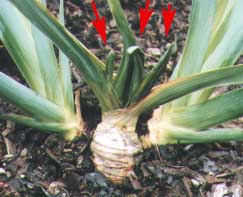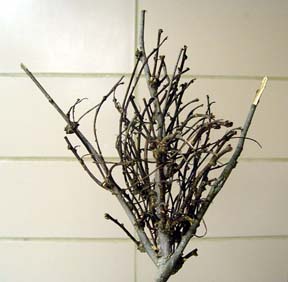Re: CULT: pineapple- confused
- Subject: Re: CULT: pineapple- confused
- From: J* I* J* <j*@usjoneses.com>
- Date: Wed, 9 Apr 2008 20:53:02 -0700
Pineappling is generally multiple distorted stalks coming from the same spot on the rhizome. Pineappling is thought to be similar to Witches Broom in other plants. In irises it is thought to be causes by damage to the growth point often because of a late freeze.  The two side fans are simple increases. Only the center shows pineappling. Driving through the countryside, you will often see trees and shrubs with small sections of twigs densely clustered together, resulting in a mass of shoots that resemble a broom. The actual cause is not always clearly understood, but can be due to various microorganisms or insects. Witches broom on Jack pine is commonly caused by Dwarf Mistletoe – a tiny flowering, almost inconspicuous parasitic plant. The mistletoe produces a tiny seed that is propelled great distances onto the growth of surrounding pine trees. There, the seed germinates, infects the new tree and begins the cycle again. In the nursery trade, the densely compact growth habit is often considered attractive. So desirable is this appearance that several types of plants infected with witches broom have been selected, propagated and released as ornamental cultivars. Many “dwarf” cultivars are examples of witches broom. Below Willow Witches Broom  John On Apr 9, 2008, at 2:48 PM, s*@aol.com wrote:
|
- Follow-Ups:
- Re: CULT: pineapple- confused
- From: "flatnflashy" <flatnflashy@yahoo.com>
- Re: CULT: pineapple- confused
- References:
- Re: Re: CULT: pineapple- confused
- From: s*
- Re: Re: CULT: pineapple- confused
- Prev by Date: Re: AB: sdlg clumps
- Next by Date: Re: Re: AB: sdlg clumps
- Previous by thread: Re: Re: CULT: pineapple- confused
- Next by thread: Re: CULT: pineapple- confused

